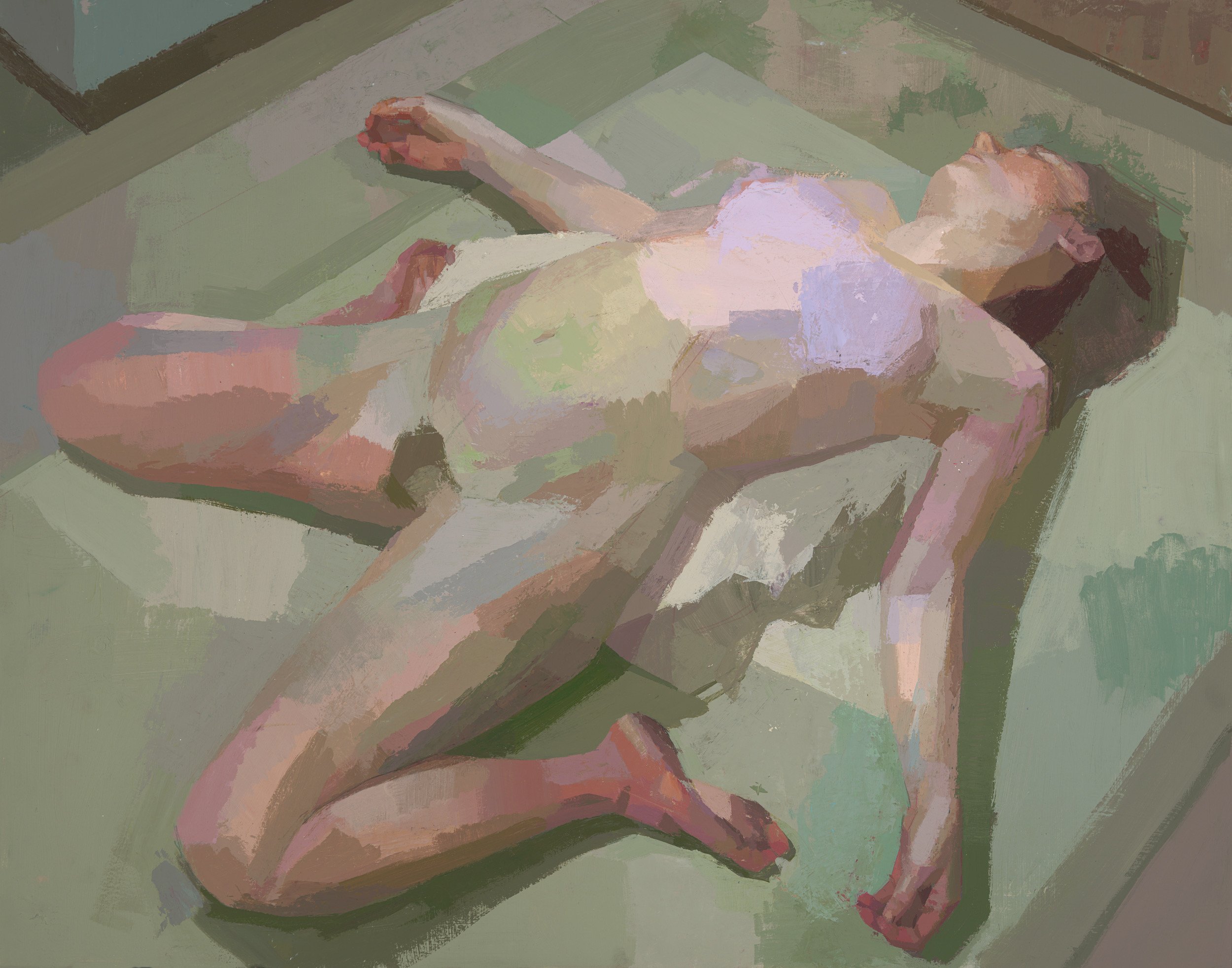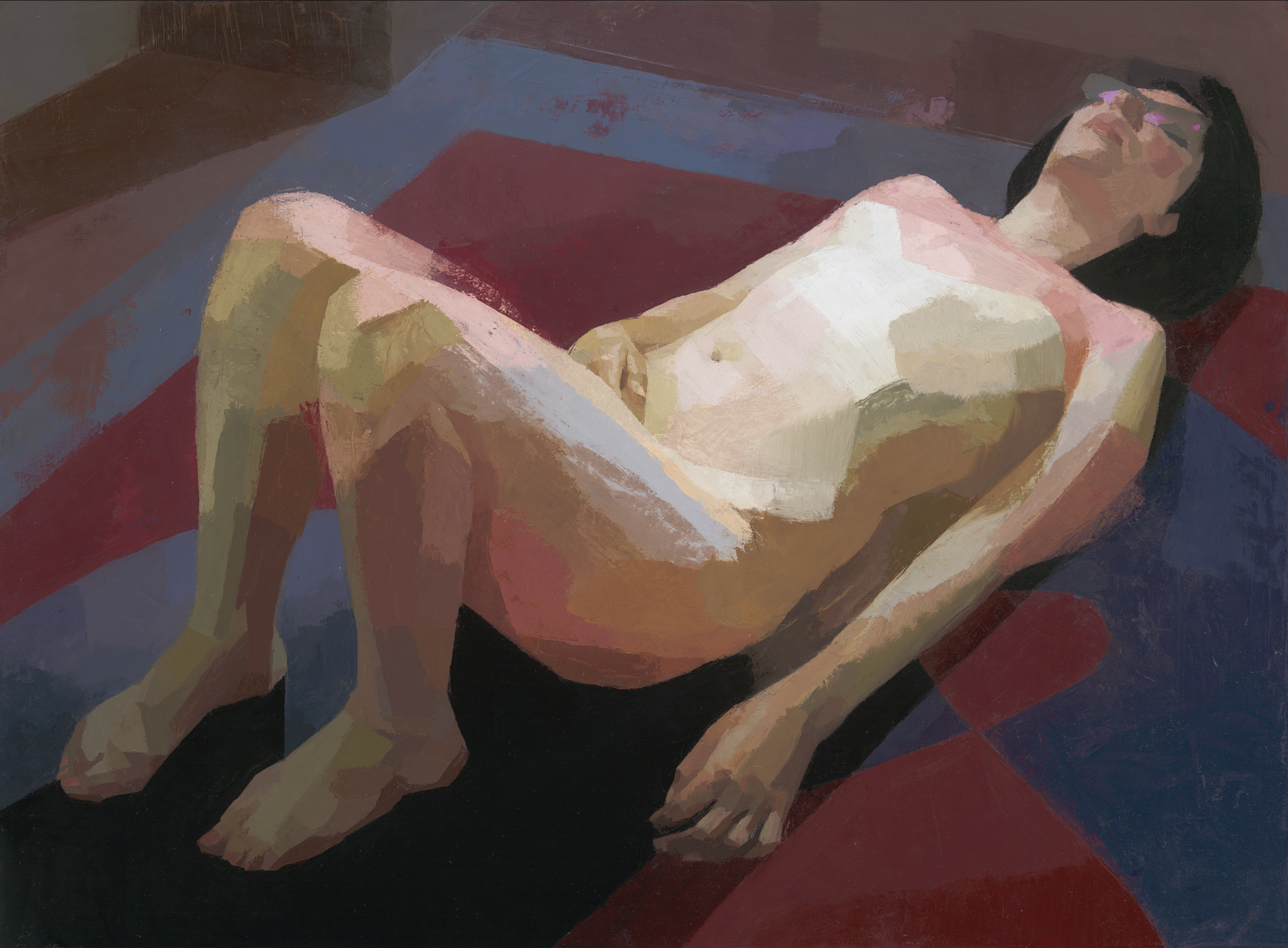Amy Erickson
Amy Erickson builds on centuries of art historical precedent, innovating upon the motif of the female nude. Erickson’s work breathes emotional depth and psychological complexity into this time-honoured subject and reclaims it from a male-dominated history.
Amy Erickson.
For more information on Erickson’s work, please visit their website or Instagram.
Erickson’s interpretation of their themes was developed by pursuing a BFA in painting from the Kansas City Art Institute and more than two years studying figure drawing and colour theory at Gage Academy of Art in Seattle, Washington. Erickson is well-versed in still lifes and figural works, but presently focuses on observational paintings of female nudes. Specifically, the series they are currently working on centers on the single female nude in the domestic space as well as on generating expansive sensory experiences of relationships between colour and form that reflect the moments spent with a model in the studio. These pictures also broadly represent Erickson’s friendships with the models depicted and the meanings that reveal themselves as they paint.
The Star, 2023. Acrylic on panel. 56 x 76 cm. All images courtesy of the artist.
Colours and shapes are central to Erickson’s oeuvre – each figure is constructed meticulously with blocks and patches of colour. The figure in The Star (2023) appears tethered to the room surrounding her while also floating unencumbered in space. Her pose is one that Erickson imagined for ten years before creating the painting, which finally came to life courtesy of one of their friends. The influence of tarot deliberately filters into the painting, as the title also refers to “The Star” card, a card in the tarot deck that represents renewal and hope. Erickson describes their paintings as “dry” and “observational,” imbuing them with symbolism and layered references lodged in their external world.
Empress 3000 BC, 2023. Acrylic on canvas on panel. 102 x 76 cm.
Empress 3000 BC (2023) was born out of Erickson’s idea of a model posed in a prim and contained area, like a doll. However, unlike the quintessential uber-feminine doll, this model sits in a position that some might deem unladylike. Erickson intended for her to dominate the room, leaving no concern for the viewer. Her apathy shatters the facade of forced female performance, or the acts women carry out to exist. Erickson also devises a dichotomy between the figure’s regality and her groundedness, like, in their words, “a clumsy 3D reconstruction of a bronze age human.”
Empress 3000 BC and The Star are enigmatic depictions of women who take up space, who are allowed to lack grace and still deserve our attention. Erickson describes this as “unaffected feminine sensuality,” lodging it distinctly outside the binary that only allows women to be angelic or repellent. The women’s bodies glow, yet their frankness denies them complete apotheosis, like the women of Rubens or Manet. Erickson’s soft brushstrokes and ethereal colour palette serve as their baseline, and through these tools they can explore the nuances of the body and all the connotations and predispositions it holds.
Dusty Girl, 2023. Oil on panel. 41 x 51 cm.
Dusty Girl (2023) deviates from Empress 3000 BC and The Star as it depicts a woman clothed. Her emotional tenor lies in her face, which Erickson describes as “haunted.” The work began as a portrait of Erickson’s friend, but as their painting process evolved, it transformed into an inscrutable and impenetrable character. Unlike their observational paintings, this work began a more psychologically-charged thread of Erickson’s work. This figure looks not at the viewer but beyond.
The crux of Erickson’s practice is observation, centring on formal material relationships they discover through this practice. Their paintings reflect their values as a queer woman and a feminist while also seeking to provide empowerment for themselves, their models, and others like them. Ultimately, Erickson’s practice is also an oppositional narrative of art history, conveying a queer truth to the patriarchal history of figure painting.
Briar Rose, 2023. Oil on panel. 56 x 76 cm.
Selected Group Exhibitions:
2023
Send Flowers, Railspur, Seattle, Washington, United States
Assemble*23, Tregony Gallery, London, UK
Stillness, Tregony Gallery, London, UK
2022
Cascadia Art Museum Gala, Seattle, Washington
Gage Spring Art Auction & Gala
2021
PERCEPTUAL, Manifest Gallery, Cincinnati, Ohio
The Nude, Figure Ground Gallery, Seattle, Washington
Annual Juried Show by Sangram Majumdar, Prince Street Gallery, New York
Portraits of the Pacific Northwest, Gage Academy, Seattle, Washington
2020
Spitting Image, Gage Academy, Seattle, Washington
Selected Awards:
2020
Second Place Spitting Image Grant, Gage Academy of Art, Seattle, Washington
2019
Puget Sound Group of Northwest Artists Scholarship Award, Seattle, Washington
Gabriella Hetu
Emerging Artist Co-Editor, MADE IN BED






